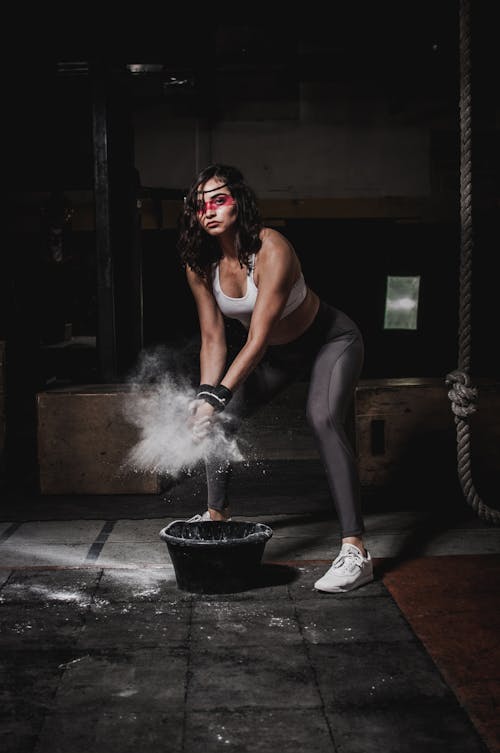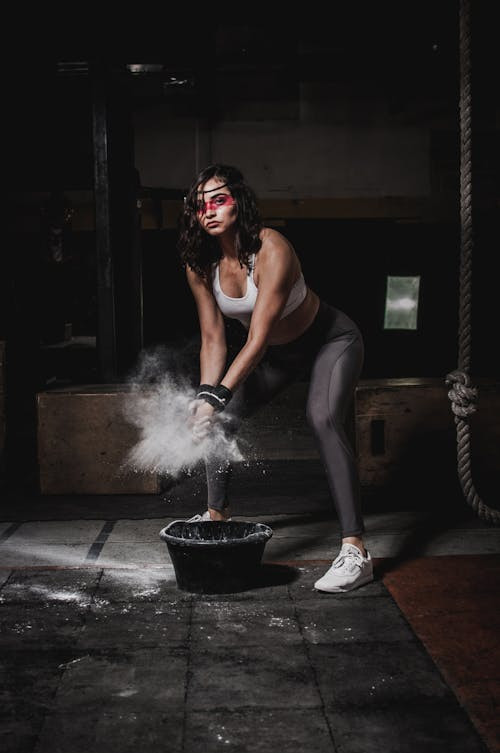Does Working Out Affect Tattoos? Absolutely, working out can affect tattoos, but the impact varies depending on several factors. At tattooat.com, we understand that you want to keep your body art looking its best while maintaining your fitness goals, so let’s explore how exercise can influence your tattoos and what precautions you can take to ensure their longevity, including understanding proper tattoo aftercare, sun protection, and the impact of skin elasticity.
1. How Does Working Out Affect New Tattoos?
Working out and fresh ink require some careful consideration. Getting a new tattoo is like getting a wound, and it needs proper aftercare to heal correctly.
1.1 The First Two Weeks: A Critical Period
During the first two weeks, your skin is especially vulnerable. According to tattoo artists at Inked Magazine, excessive sweating and friction can increase the risk of infection and distort the tattoo’s appearance.
1.2 Potential Risks of Exercising Too Soon
- Infection: Sweat contains bacteria that can enter the open wound, leading to infections.
- Fading: Excessive sweating can cause the ink to leach out, resulting in a faded tattoo.
- Distortion: Friction from clothing or equipment can irritate the skin and distort the design.
1.3 Expert Recommendations for New Tattoos and Exercise
Most tattoo artists recommend avoiding strenuous workouts for at least the first week or two. Lighter activities like walking are generally okay, but it’s essential to listen to your body and avoid anything that causes excessive sweating or friction around the tattoo.
 Fresh tattoo on arm
Fresh tattoo on arm
2. How Does Working Out Affect Old Tattoos?
Once your tattoo is fully healed, the impact of working out shifts. Older tattoos are more resilient, but certain factors can still affect their appearance over time.
2.1 Muscle Gain and Skin Stretching
Significant muscle gain can stretch the skin, potentially distorting the tattoo. The extent of the distortion depends on the tattoo’s location, size, and design.
2.2 Weight Fluctuations and Tattoo Appearance
Weight gain or loss can also affect the appearance of tattoos. Rapid weight changes can cause the skin to stretch or sag, altering the tattoo’s shape and clarity.
2.3 The Role of Skin Elasticity
Skin elasticity plays a crucial role in how well your tattoo holds up over time. As we age, our skin naturally loses elasticity, making it more susceptible to stretching and sagging.
3. Which Body Parts Are Most Affected by Working Out?
Certain body parts are more prone to stretching and distortion due to muscle gain or weight fluctuations. Knowing these areas can help you take extra precautions to protect your tattoos.
3.1 Areas Prone to Stretching
| Body Part | Why It’s Affected |
|---|---|
| Arms (Biceps) | Significant muscle growth can stretch the skin. |
| Legs (Thighs) | Muscle gain and weight fluctuations. |
| Abdomen | Weight gain and muscle development. |
| Back (Latissimus) | Muscle growth and skin expansion. |
3.2 Tips for Protecting Tattoos in High-Impact Areas
- Moisturize Regularly: Keeping your skin hydrated can improve its elasticity and resilience.
- Gradual Changes: Avoid rapid muscle gain or weight fluctuations to minimize skin stretching.
- Sun Protection: Shield your tattoos from the sun to prevent fading and damage.
4. How to Protect Your Tattoos While Working Out
Protecting your tattoos during workouts involves a combination of proper aftercare, preventive measures, and mindful exercise habits.
4.1 Immediate Aftercare Tips
Follow these steps immediately after getting a tattoo:
- Keep it Clean: Gently wash the tattooed area with mild, fragrance-free soap.
- Pat Dry: Use a clean towel to pat the area dry, avoiding rubbing.
- Apply Ointment: Apply a thin layer of tattoo-specific ointment to keep the skin moisturized.
4.2 Protecting Your Tattoo During Workouts
| Protection Method | Description |
|---|---|
| Protective Gear | Wear loose-fitting clothing or breathable bandages to minimize friction and irritation. |
| Hygiene | Shower immediately after working out to remove sweat and bacteria. |
| Moisturizing | Apply a moisturizer to keep the skin hydrated and prevent it from drying out and stretching. |
4.3 Long-Term Tattoo Care for Active Individuals
- Sunscreen: Protect your tattoos from UV rays with a high-SPF sunscreen.
- Hydration: Drink plenty of water to keep your skin hydrated from the inside out.
- Healthy Diet: A balanced diet rich in vitamins and minerals supports skin health.
5. What Are The Best Exercises To Protect Your Tattoos?
Choosing the right exercises and making modifications can help minimize the impact on your tattoos, especially during the healing process.
5.1 Low-Impact Exercises
Low-impact exercises are gentle on the skin and reduce the risk of irritation and stretching.
- Walking: A great way to stay active without putting excessive stress on your skin.
- Yoga: Improves flexibility and strength while minimizing friction.
- Swimming: A low-impact activity that’s easy on the joints and skin.
5.2 Modifying Your Routine
- Adjusting Intensity: Reduce the intensity of your workouts to minimize sweating and friction.
- Avoiding Direct Contact: Modify exercises to avoid direct contact between the tattoo and equipment.
- Choosing the Right Gear: Opt for loose-fitting, breathable clothing to reduce friction.
 Man doing yoga
Man doing yoga
6. Can Certain Tattoo Placements Be More Affected by Working Out?
Tattoo placement can significantly influence how much it’s affected by working out. Areas with more muscle movement or skin stretching are more susceptible to changes.
6.1 The Impact of Tattoo Location
| Tattoo Location | Potential Impact |
|---|---|
| Biceps | Muscle growth can stretch and distort the tattoo. |
| Thighs | Weight fluctuations and muscle gain can alter the tattoo’s appearance. |
| Abdomen | Skin stretching during weight gain or pregnancy can affect the design. |
| Rib Cage | Breathing and movement can cause friction and stretching. |
6.2 Strategies for Different Tattoo Locations
- Arms and Legs: Avoid exercises that cause rapid muscle growth in these areas.
- Abdomen: Maintain a stable weight and avoid extreme fluctuations.
- Rib Cage: Wear loose-fitting clothing to minimize friction.
7. What Kind of Tattoos Are Least Affected by Working Out?
The design and style of your tattoo can also influence how well it holds up to the rigors of working out. Simpler designs and certain styles tend to be more resilient.
7.1 Minimalist Tattoos
Simple, minimalist designs with clean lines are less likely to show distortion compared to intricate, detailed pieces.
7.2 Styles That Withstand Time
- Traditional Tattoos: Bold lines and classic designs tend to age well.
- Blackwork Tattoos: Solid black ink is less prone to fading and distortion.
7.3 Designs to Avoid
- Fine-Line Tattoos: Thin lines can fade or blur more easily with skin stretching.
- Watercolor Tattoos: These delicate designs can fade quickly if not properly protected.
8. Does Sweating Affect Tattoos?
Sweating is a natural part of working out, but it can pose risks to new tattoos and affect the longevity of older ones.
8.1 The Impact of Sweat on New Tattoos
Sweat contains bacteria that can lead to infections in new tattoos. It can also interfere with the healing process, causing the ink to leach out and fade.
8.2 How to Minimize Sweat-Related Risks
- Keep the Area Clean: Wash the tattooed area gently with mild soap and water after working out.
- Use Antibacterial Products: Apply a thin layer of antibacterial ointment to prevent infection.
- Wear Breathable Clothing: Choose moisture-wicking fabrics that keep sweat away from the skin.
8.3 Long-Term Effects of Sweat on Older Tattoos
While older tattoos are less susceptible to infection, excessive sweating can still cause fading over time. The salt in sweat can break down the ink pigments, leading to a duller appearance.
9. Maintaining Skin Elasticity: A Key Factor
Skin elasticity is crucial for preserving the appearance of your tattoos. As we age, our skin naturally loses elasticity, but there are steps you can take to maintain it.
9.1 What Affects Skin Elasticity?
- Age: Natural aging process reduces collagen and elastin production.
- Sun Exposure: UV rays damage collagen and elastin fibers, leading to premature aging.
- Hydration: Lack of moisture can cause the skin to become dry and less elastic.
- Nutrition: A poor diet can deprive the skin of essential nutrients needed for elasticity.
9.2 Tips for Improving and Maintaining Skin Elasticity
- Hydrate Regularly: Drink plenty of water to keep your skin hydrated.
- Eat a Healthy Diet: Consume foods rich in antioxidants, vitamins, and minerals.
- Use Moisturizers: Apply moisturizers containing ingredients like hyaluronic acid and collagen.
- Protect from the Sun: Use sunscreen daily to prevent UV damage.
- Consider Supplements: Collagen supplements may help improve skin elasticity.
 Woman drinking water
Woman drinking water
10. What To Do if Your Tattoo Stretches?
Despite your best efforts, tattoos can sometimes stretch or distort due to various factors. Knowing how to address these changes can help you maintain their appearance.
10.1 Options for Tattoo Correction
- Touch-Ups: A tattoo artist can touch up the tattoo to restore its original appearance.
- Cover-Ups: If the distortion is significant, a cover-up tattoo can be used to create a new design over the old one.
- Laser Removal: In some cases, laser tattoo removal may be an option to remove or lighten the tattoo.
10.2 Consulting with a Tattoo Artist
It’s essential to consult with a skilled tattoo artist who can assess the damage and recommend the best course of action. They can provide expert advice on touch-ups, cover-ups, or laser removal options.
10.3 Preventing Further Stretching
Continue to follow the tips for maintaining skin elasticity and protecting your tattoos during workouts to prevent further stretching or distortion.
FAQ: Does Working Out Affect Tattoos?
Here are some frequently asked questions about how working out affects tattoos:
1. Can I work out immediately after getting a tattoo?
No, it’s generally recommended to avoid strenuous workouts for at least the first week or two to allow the tattoo to heal properly.
2. How soon can I start working out after getting a tattoo?
Most tattoo artists recommend waiting at least 48 hours before engaging in light activities and a week or two before resuming intense workouts.
3. Does sweat affect new tattoos?
Yes, sweat can increase the risk of infection and cause the ink to leach out, leading to fading.
4. How can I protect my tattoo while working out?
Wear loose-fitting clothing, keep the area clean, and apply a moisturizer to keep the skin hydrated.
5. Can muscle gain stretch my tattoo?
Yes, significant muscle gain can stretch the skin and distort the tattoo’s appearance.
6. What body parts are most affected by working out?
Arms, legs, abdomen, and back are more prone to stretching due to muscle gain or weight fluctuations.
7. How can I maintain skin elasticity?
Stay hydrated, eat a healthy diet, use moisturizers, and protect your skin from the sun.
8. What kind of tattoos are least affected by working out?
Minimalist tattoos with simple designs and bold lines tend to withstand time better.
9. What should I do if my tattoo stretches?
Consult with a tattoo artist to discuss options for touch-ups, cover-ups, or laser removal.
10. Can sunscreen protect my tattoos?
Yes, using sunscreen daily can prevent UV damage and protect your tattoos from fading.
Working out doesn’t have to compromise your tattoos. By understanding the potential impacts and taking the necessary precautions, you can maintain your fitness goals while keeping your ink looking vibrant and sharp. Remember, tattooat.com is your go-to resource for all things tattoos. We offer a vast library of tattoo designs, a curated list of talented artists and studios, and detailed guides on tattoo care.
Ready to explore the world of tattoos?
Visit tattooat.com today to discover your next tattoo design, find a skilled artist near you, and learn everything you need to know about tattoo care. Let us help you make your tattoo dreams a reality!
Address: 1825 SW Broadway, Portland, OR 97201, United States
Phone: +1 (503) 725-3000
Website: tattooat.com


